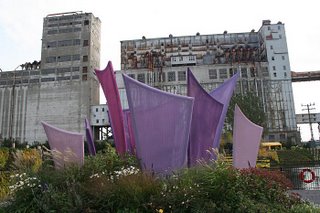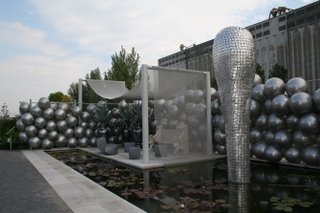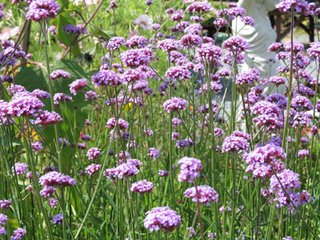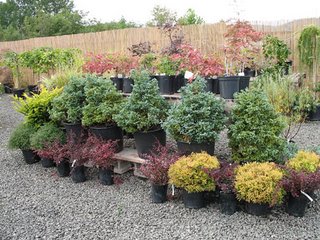 If you’re going to be in Montreal in the next couple of weeks, you gotta go see Flora. If you’re not going to be there in that time, wait til next spring—then you gotta go see Flora.
If you’re going to be in Montreal in the next couple of weeks, you gotta go see Flora. If you’re not going to be there in that time, wait til next spring—then you gotta go see Flora.Flora who, you ask?
International Flora Montreal This has to be the most amazing garden themed display in the country. Now, I can’t claim to have been to every intriguing garden across the country—not by a long shot—but this is a phenomenal, breathtaking, and FUN exploration of gardening and garden design.
Why am I so besotted with this show?

In the first place, it’s a living, longterm display—this year from mid-June to mid-October—whereas shows like Canada Blooms are short flashes in the pan, here today, gone four days later. Come back to Flora week after week and see how the gardens change over the season.
VIA Rail came up with this wonderful travel theme called the Garden Route There are twelve gardens from Halifax to Windsor, Ontario, all accessible by one train route or another. The marvelous people who put on Flora, and the team at VIA, made it possible for me to go to Montreal, Ottawa, Toronto, Burlington/Hamilton and Windsor, to visit some of the gardens on the route. Naturally, I’ve already been to Halifax’s Public Gardens, and to Kingsbrae in New Brunswick—another of those “You GOTTA go” places—but I did cartwheels, figuratively if not literally, when I was asked to go. And it didn’t take long to get me packed and into Halifax to meet my train.
I love trains. I despise flying now, especially since Canjet is no more—sure, flying is fast, but it reminds me of moving livestock, crammed into too—small quarters. Give me a train any day of the week, provided I’ve got the time to take to travel languorously across the country to my destination. Happily, in this case, I did. Travelling by train is infinitely civilized…not only are we not racing and crowded and stressed, we get to actually SEE a great deal of the amazing country we live in. Going Easterly class (first class on The Ocean, which sadly is the only passenger train left in the Maritimes) is definitely the crème de la crème of train travel. We had a ‘learning coordinator’, who entertained us in the park car at the end of the train, presented us with complementary champagne to toast the trip’s beginning, and gave us all kinds of insights into what it’s like to live in the Maritimes. (For those unfortunates who don’t live here, of course.) The sleeping cars are comfortable, well lit, with huge windows looking out on the racing landscape; the meals featured maritime flavours and wines from Jost, Domaine de Grand Pre, Gaspereau Vineyards, and other Nova Scotian wineries; the beds, while not huge, are comfortable, and I dunno where VIA gets their duvets, but I want one!
 And though the sun sets too early these days, it was still up when we arrived in Miramichi--surely one of the most gloriously beautiful places in the country. No wonder David Adams Richards writes so movingly of that region.
And though the sun sets too early these days, it was still up when we arrived in Miramichi--surely one of the most gloriously beautiful places in the country. No wonder David Adams Richards writes so movingly of that region. So I arrive in montreal, the city that never sleeps, at 8 this morning—and two hours later, after getting checked in at the Holiday Inn Midtown, I’m en route to see Flora.
Here’s the best description of where the gardens are located, from the Flora website.
INTERNATIONAL FLORA MONTREAL 2006 take place on the Quays of the Old Port of Montreal, at the Lock Gardens in the area between the railway bridge and the Mill bridge. The Old Port is rich in history and culture and is one of the most important recreational and tourist destinations of Montreal. It benefits from a captive clientele of more than 7 million visitors who come every year to Old-Montreal and on the Quays of the Old-Port of Montreal.

Imagine all of these unique, vibrant gardens, planted and thriving along the locks heading down to the mighty river. For a backdrop, the ancient grain elevators brood on the skyline, providing the perfect boundary on more than fifty different theme gardens.
There are tranquil gardens when you can pause and reflect...

...and gardens where you can actually delight in the designer's sense of humour

There are gardens with ecological themes, as with this water-conserving planting,

And gardens that are just plain whimsical

Now, I haven’t had time to review all the literature—or all the photographs I took—because oddly enough, I need some sleep! But on the train tomorrow, I’ll do up the photos from this afternoon’s visit to the next stop on the tour, and let you know more about the trip. This is just a teaser to get you started.





